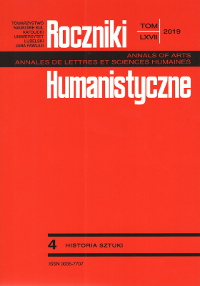Projekty wnętrz i mebli zaprezentowane na „wystawie Architektury i wnętrz w otoczeniu ogrodowem” w Krakowie w 1912 roku
Interior and furniture designs presented at the exhibition “Architecture and Interiors in Garden Settings” in Krakow in 1912
Author(s): Agata WójcikSubject(s): Fine Arts / Performing Arts, Architecture, History of Art
Published by: Towarzystwo Naukowe KUL & Katolicki Uniwersytet Lubelski Jana Pawła II
Keywords: interior design; furniture; applied arts; Krakow
Summary/Abstract: The aim of this study is to analyze the architecture of residential interiors and furniture making presented at the exhibition in 1912, to indicate the sources of inspiration for designers and to place them in the context of foreign furniture making. The sources of information were the exhibition catalog, press articles, and the archival materials stored in the National Archives in Krakow that had not been used so far, as well as photographs from the collections of the Print Room of the Academy of Fine Arts in Krakow and the Museum of the Jagiellonian University.The interiors and furniture presented by the artists from the society for Polish applied arts (TPSS) at the Krakow exhibition in 1912 perfectly matched the trends prevailing in designing around 1910. How far they were from the curvy-line Art Nouveau. The designers consciously and creatively used their native tradition, especially the furniture making of the Biedermeier period and folk art. On the one hand, Polish artists drew from the architecture of manor interiors, and on the other they were close to the inspiration of an English home. Their projects can be compared with the works of Austrian artists from the circle of the Vienna Workshop and German artists associated with the Deutscher Werkbund. They were a harbinger of simplified, geometrized, folk-inspired, influencing the beauty of the material, Polish furniture of the interwar period. The equipment for the house of a worker and a craftsman being an example of cheap furniture was characterized by solidity, modesty, operating with economical, but noble forms, inspired by folk ornamentation. They were the beginning of attempts by Polish designers to create minimalist, functional, solid and cheap equipment that were continued in the interwar period.
Journal: Roczniki Humanistyczne
- Issue Year: 67/2019
- Issue No: 4
- Page Range: 109-140
- Page Count: 32
- Language: Polish

